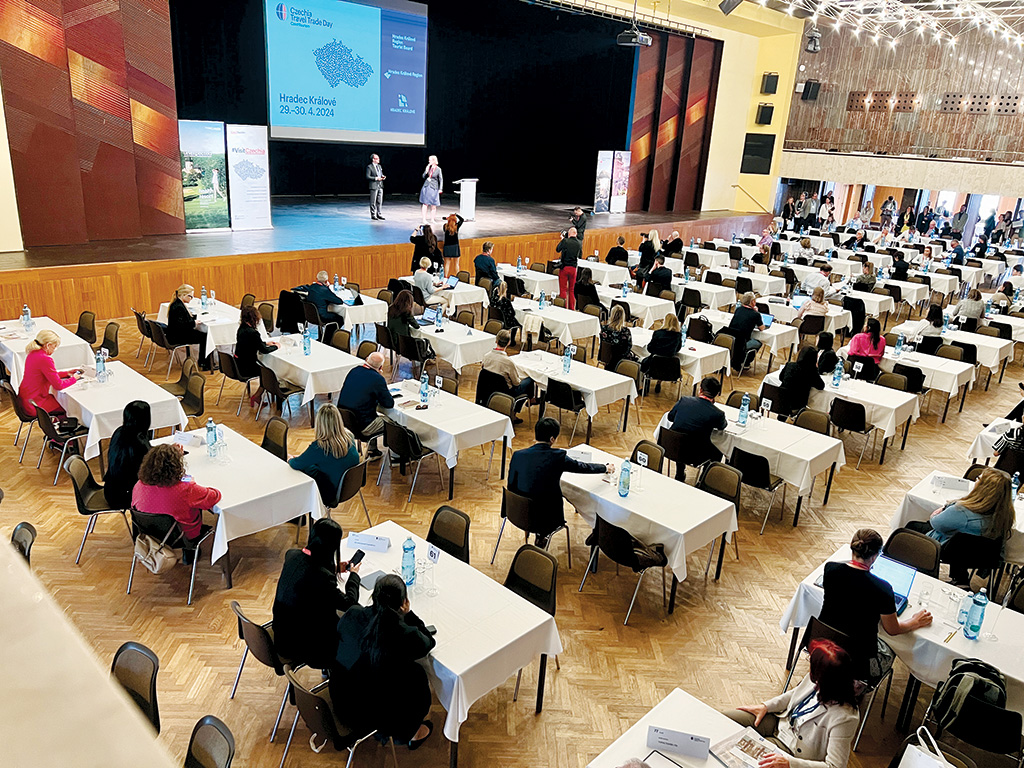


Tourism to Czechia from the Middle East continues to rise with visitor numbers almost back to pre-Covid figures, going by CzechTourism data on the two major source countries of Saudi Arabia and the UAE – while overall international arrivals are back to 2019 levels. To maintain that momentum, the European country has been showcasing the breadth of its travel products to the trade outside its core source markets, promoting family-friendly getaways, spa tourism, cultural experiences, as well as MICE tourism.
Agents and journalists from across the Middle and North Africa (MENA) were among more than 90 participants at this year’s Czechia Travel Trade Day. Held in the city of Hradec Králové, near the country’s border with Poland, the event connected agents and hosted buyers with Czech tourism businesses.
“[The workshop] is a great opportunity for us to present and promote the region and to strengthen the overall awareness of our region also abroad, because we have a lot to offer in the field of tourism,” says Martina Berdychová, Deputy Governor of the Hradec Králové Region for Tourism and Culture.
Participants were able to attend one of four fam trips around the nature-rich region, including leisure and MICE offerings. Besides the city of Hradec Králové itself, itineraries took in the Kladsko Borderlands, the Giant Mountains and the Bohemian Paradise.
Holding the event in different regions every year raises awareness of tourist offerings outside Prague, František Reismüller, Director of Czech Tourist Authority – CzechTourism, said at the event. The capital city remains the biggest draw for international tourists in Czechia.
International arrivals finally surpassed 2019 numbers last year. The CZSO statistical office reported approximately 22 million hotel guests in 2023, 13.5% more than the previous year. The number of overnight stays correspondingly increased 10.7% to total 56 million nights, but this lags behind 2019 figures. Every region of Czechia saw a growth in international traffic.
Domestic tourists outnumber international tourists slightly. But at 92 euros per day, foreign visitors spend three times as much as locals (36 euros per day). “That’s why we hope to reach a high number of foreign guests,” Reismüller said.
Nearly 28,000 tourists from KSA visited Czechia in 2023, the same as in 2019. It was an increase of 48% over 2022. They stayed for 105,037 nights versus approximately 131,000 nights in 2019.
The UAE reported almost 25,000 visitors in 2023, up 53.3%, or a total 69,182 overnight stays. Numbers here aren’t quite back to 2018’s 34,000 visitors and 95,000 nights.
However, 2024 has gotten off to a strong start. Overall international arrivals are up 9.9% in the first quarter over 2023 . Saudi Arabian numbers are at their strongest since 2015 with 3,300 visitors staying a total of 11,631 nights so far this year. It is a 73% increase over the corresponding period last year. There were 8,676 overnights from the UAE, a 32% increase.
More than 6,600 visitors from the two countries travelled to Czechia in the first quarter of this year, staying about 20,000 nights in total.
In both cases, Prague received the majority of visitors. Smaller numbers headed to the spa region of Karlovy Vary, followed by South Bohemia, South Moravaia and Hradec Králové.
The Hradec Králové Region received more than 1.5 million tourists over the course of 2023. It is in fourth most popular region in Czechia for tourists, says Martin Soukup, director of the Hradec Králové Regional Tourism Centre.
The most popular source markets for the region are three neighbouring countries, Germany, Poland and Slovakia.
MENA agents on the recent fam trip said the visit helped them understand new products, but pointed to the need for offerings that align closely with Middle Eastern customers’ wish lists. Most prominent among these are a request more facilities that cater to Islamic travellers.
“Czechia is an emerging market in Middle East that holds significant potential to expand its their operations with their hospitality and warmth. I am sure Czechia can offer exceptional service by tailoring products and services that cater to the preferences of different interests within the region and can enhance satisfaction, loyalty and goodwill among Middle Eastern clients,” says Namsheed KM, Senior Team Leader at Qatar’s Regency Travel and Tours.
Middle Eastern visitors stay in Czechia for an average of four nights. Outside Prague, some stay much longer, up to two or three weeks in some cases.
CzechTourism also returned to Arabian Travel Market in May, supporting a delegation of eight partners. The tourist board unveiled a new collection of coins by Czech Mint at the event, including one designed by Emirati artist Ali Al Ali. It blends Emirati culture with Czech heritage and seeks to inspire collectors to rise above difficult moments. It’s a marketing idea that certainly speaks to the moment, as the industry lurches from one travel crisis to another.NEW WELLNESS CAMPAIGN; ONE-STOP DIGITAL REGISTRATION
With more people finding it hard to look up from their phones, Czechia is highlighting the best possible reason to do so: spa treatments. CzechTourism’s big play for tourists this year and next is a campaign called Unexpected Wellbeing, in line with its theme of active tourism.
The new campaign positions Czechia as one big spa and aims to show visitors how to relax, exercise and recuperate while travelling – whether in formal wellness facilities or simply by immersing themselves in nature.
The new campaign picks up from the country’s 2023 focus on Unexpected Traditions.
Tourism contributed CZK134.3 billion ($5.76 billion) to the Czech economy in 2022, about 2.18 per cent of gross domestic product. It employs approximately 225,500 people.
As it looks to bring in more visitors, Czechia is also racing to make the travel experience easier while reducing administrative burdens around data collection and processing.
The Ministry of Regional Development is developing a single-window digital solution that it describes as a new approach to registration.
“Imagine not having to tediously fill out paper forms when you visit an accommodation facility. Instead, we are entering the era of digital tourism, where a single digital location will be used to register tourists in our accommodation facilities,” Deputy Prime Minister for Digitization and Minister of Regional Development Ivan Bartoš said in a recent statement.
The registry will provide stakeholders across the tourist chain with real-time data, so mayors see how many tourists they currently have in their area and what fees are payable, for example. Bartoš said the portal would help each regional authority plan and develop new infrastructure.
The portal will comply with upcoming European Union regulations around tourist movements. In October, the EU will roll out a new EU Entry/Exit System (EES) to replace the current practice of manually stamping passports, automating the registration of travellers from third countries each time they cross an EU external border.
“Modern times call for modern solutions – we will not stand back, but we will meet them,” Bartoš said.
